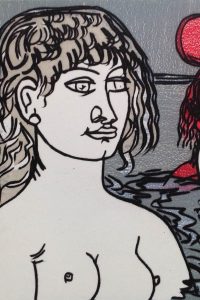The friendship and esteem for Tono Zancarano (Padua, 1906-1985) as man and artist has been crucial for Giulio Bargellini’s approach to collecting, stimulating his curiosity for the contemporary artistic thought.
Zancanaro believed that the intelligence of man is expressed through the work and, since he passed through Fascism, the Second World War and the Resistance, even after many years he felt the difficulty of the times, acting as a person and artist in the service of “different”, of social outcasts, of poor people, identifying the reason as the best weapon to combat any type of oppression.
The opening to interpersonal relations, to be free from preconceptions by inclination and choice, allowed the artist to know and develop continuous relation with the leading figures of the time, finding inspiration for an incredibly rich and versatile production in the techniques of drawing, carving, painting, ceramic, mosaic and photography.
Never turned into an anonymous eclecticism, by virtue of a clear stylistic characterization, his art finds a line of coherence thanks to the persistent propose of subject and themes, as in the cycle of Gibbo and Demopretoni – respectively ant-Fascist and anti-clerical – the Carusi and Mondine form Roncoferraro, as well as the endless series of female figures, from the Levane to the Circi.
In addition to the contribution given to the realizations of scenery and costumes for the main Italian theaters, in thirty years he realized also a large corpus of illustrations of famous literary texts.
As a proof of the long relation of friendship that has bound them, Bargellini collected in the course of time several works that fully give us back the artist’s activity.








